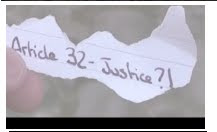Tuesday, 10 May 2011
Group: Navigation: Evaluation Posts:
Evaluation Questions individual:
Alex:
Evaluation Questions individual:
Sam:
Evaluation Questions individual:
Group 11:
Question 4:
Question 5:
Question 7:
Link to our Productions:
HITLIST:
Preliminary Task:
The Woods:
Storyboard Animatic:
Monday, 9 May 2011
Group Evaluation: Question 7
I believe we have learnt to plan our shoots effectively, to make sure we get all the footage we need from each shoot. For our preliminary task, we did very little planning which consisted of a brief discussion in class and talking about our shots just before we were going to film them. For our final product, however, we completed storyboards and shot an animatic so that we knew exactly what we were shooting on our shoots. We also conducted call sheets and risk assessments for each shoot which we did not for our preliminary task.
We have also enhanced our editing skills using Adobe Premiere Elements 8.0; in our final product we used many effects on our footage such as a black and white colour wash, fade to white and adjusted the RBG colour settings on some shots. In our preliminary task, we didn't use any effects and simply cut our footage and added music.
Group:Question 4; Who would be the audience for your media product?
Sunday, 8 May 2011
Group: Audience Research Analysis:
- The response was very encouraging, everyone understood what was taking place within the opening and also understood the colour scheme with black and white colour wash meaning the past and the ordinary coloured shots were in the present. Demonstrating it was not confusing for the audience.
Question 2: What Genre do you think it is?
- Each interviewee thought that the opening was in a Thriller genre, due to the iconography used, the stock characters and also conveyed the key conventions Thrillers.
Question 3: Who do you think the protagonist was?
- Most people saw that the protagonist was the detective, however some believed it was the killer due to the fact that the audience were positioned with him, and some believed it was Alex, as he was the main character within our opening and has most time on screen.
Question 4: Who was the antagonist?
- The audience all worked out that the antagonist was the psychological killer as he was the murderer and was doing things that were evil.
Question 5: What was the victim's role, what was his profession?
- Most of our audience believed that the victim's role was to be killed in order to set up the film (to have a detective chasing a murderer). They also thought his profession was a high up city worker such as a banker or journalist, and was middle-class.
Question 6: What do you think of the sound used, is it used effectively?
- Our audience believed that the sound was used very effectively and that it helped to create tension and was very atmospheric. They believed that the sound fit the opening perfectly.
Question 7: Are the titles clear?
- Our audience found are titles perfectly clear and they could all read them easily, also the amount of time the titles were on the screen was perfect to allow all our audience to read them.
Question 8: Do you think the titles fit the genre?
- Our age group for our target audience thought the fonts fitted the genre perfectly, however the older generation believed they were too fancy and preferred simplistic titles.
Tuesday, 26 April 2011
AT Evaluation Questions: 1,2,3 and 6
The form of our opening was conventional for the thriller genre as it has followed the conventions for a thriller opening however, our production started as a thriller/horror with use of some parts gore, however from our product being viewed it was shown that it was soley a thriller film.
The way we went about to fulfil these conventions were to use character exposition of the antagonist and protagonist in the opening sequence. The technical effect we used were mise-en-scene especially for costume and the lighting conditions for the killers bedroom, which was dim lighted. From our research we learnt that dim lighting was a stereotype for thriller films and to follow conventions we did the same. Also as shown in the picture below we found our footage to be red in colour therefore we decided to add a colourwash on to it making it more blue which adds to the cold feel of thriller film conventions.
 Research from the film Law Abiding Citizen(2009, Gary Gray) showed that character exposition is key and from undertaking a shot by shot analysis on it helped to show the framing of the antagonist and protagonist this gave great insight into our opening and helped us agree on the character exposition.
Research from the film Law Abiding Citizen(2009, Gary Gray) showed that character exposition is key and from undertaking a shot by shot analysis on it helped to show the framing of the antagonist and protagonist this gave great insight into our opening and helped us agree on the character exposition.
The way our production develops conventions is the way it has two time periods being inter cut to go against the conventional asynchronous narrative where it starts at the end and reveals from the beginning how it happened, we just decided to take that and have it inter cut to show insight and provide dramatic irony to the audience by creating a linear narrative.
How does your media product represent particular social groups?
For Mise-en-scene we knew that the best way to represent the social groups in our media product most effectively was through costume. The way we represented the working class killer was through him wearing a hoody, trackies and a balaclava to conseal his face. This is a dominant ideology of working class costume of which we wanted to represent. The two other characters are middle class ( the detective and journalist) both reinforce stereotypes of middle class males being well dressed(in suits) and well educated shown by there clothing and shown by the journalists house meaning he is succesful. 
The working class character is the killer who is represented in a negative way reinforcing dominant ideologies however this is challenged by the clues left behind showing that the killer is intelligent and working class social groups aren't associated with being clever. This helps to challenge ideologies and to get the audience attracted to the logic behind this man and to try and gain insight into why he is doing it.
Also what does reinforce stereotypes about males is there need to be dominance and aggressive which is shown by the ruthless killer as he takes his next victim who is vulnerable. Also crimes are associated with the working class people and is shown here in our media product. For the one bit of dialogue we have in our product is from the detective of which is deleivered in a laconic way.
What kind of media institution might distribute your media product and why?
I think our product would most likely be an industrial film due to it following most conventions of the thriller genre. Companies that are most likely to distribute thriller films are those that specialise in this genre or media conglomerates such as Universal who are merged with British film company working title. Thriller films appeal to a large audience of about 15- 40+ as they appeal to many sub genres aswell such as action, horror and psychological.
Previously the British film council has supported British films in helping to support funding for helping to produce and distribute there films, however since the scrapping of the UK film council has lead to less British films being made.
Click here to see my law abiding citizen shot by shot analysis.
CM: Evaluation questions: 1,2,3,6
We introduced violence into our sequence; the violence is merged with the detective finding a dead body and looking at the different parts, e.g. the victim’s shoe, then cutting to the victim tying his shoelace before being murdered. This is a convention of thriller films; to show the crime scene and the detective also usually looking at clues left by the killer too.
The antagonist left a clue behind at the crime scene, and from it the audience can infer that the killer is murdering out of vengeance and revenge, due to the keyword left behind being “Justice” this is again a convention of serial killer films, such as 'Se7en' (Fincher, 1999) whose serial killer has a specific motive and way of killing his victims, thus giving the audience an insight into the killers inner-workings.
Our film opening is in a linear narrative, and it shows two lines of action inter-cut, plus a small amount of scenes from a flash-back. We believed this is developing on the forms of real thriller film openings, as they usually show a flash-back at the start and then continue the narrative in the present, whereas our production integrates the flashbacks and main line of action into the same sequence. In order to establish that the flash-backs were in the past we edited them by putting a black and white colour wash onto those cuts to connote the past. This technique is again a common convention of Thriller films to show different time frames.
Click here to view our research on Conventions of Thrillers:
How does your media product represent particular social groups?
Click here to view my research on particular social representations.
What kind of media institution might distribute your media product and why?
I feel that our product would most likely be produced by a conglomerate studio, and therefore be an industrial film. This is because our production conforms to many thriller conventions. Thriller films appeal to a mass audience of 15- 45+ as they feature action, appealing to the younger audiences, and mystery which appeals to the wider audience.
Our production is a conventional thriller film, so would be produced and distributed by a conglomerate, most likely New Line Cinema as they have created films similar to our chosen genre, such as "Se7en" and the "Blade: Trinity" including many other thriller films. Thus meaning that they have the knowledge of how to produce a Thriller and also invest heavily in Thriller films making it likely that they would be interested in producing our film.
Furthermore, using information from www.imdb.com the majority of the top 250 films in the world are Thrillers. Showing more evidence that thriller films are very popular in the current market and will always attract a large audience. Which will almost inevitably make the film profitable.
What have you learnt about technologies from the process of constructing this product?
- I have learnt how to use the HD cameras that we recorded our footage on for our production.
- Also I have learnt to use Adobe Premiere which we used to edit our footage by cutting, applying effects and organising our shots, which took time to get to grips with but eventually became second nature and I understood how much of a difference editing makes to productions. Furthermore I realised how time consuming editing is and that if one shot doesn't line up to the millimeter the whole sequence doesnt' work and either needs to be re-shot or cut down the clip a fraction. You could even add a blurring effect so that shots that don't completely line up correctly don't get noticed.
- Furthermore, we learnt to add titles to clips, which allows the audience to gain further insight into the film and allows locations to be discovered.
- Also using premiere, we cut and moved clips around allowing seamless editing and appears continuity edited.
- Also with Premiere, I learnt to both compress time and expand time using the time stretch tool, which allowed us to speed up clips or slow them down.
- Leading onto this we used special effects, which again gave our production a more professional look, helping with the forecast that this film would be picked up by a conglomerate.
- Lastly on Premiere, I learnt to put music onto a clip and noticed how much of a difference it makes and transforms a regular amature film into an opening of a professional film. The music builds tension and creates an suspense that helps to drive the narrative. It creates a dark atmosphere within our production.
- Also I learnt to use Prezi, a website which helps creating very engaging power-points, this enabled me and my group to create an interesting and exciting pitch, in order to get our opening green-lighted. Again Prezi took time to get used to but after practicing on on the website I became confident and able with the software. On Prezi I have made two PowerPoint's each very engaging and dynamic.
- Furthermore, I have also learnt to use "Slideboom"which is an online source that allowed my PowerPoint to be able to be uploaded online, and obtain an embed code. An embed code allowed me to post my PowerPoint onto the blog. This was a very helpful tool which I never knew existed, and is very simple to use.
- Another useful website that I have discovered whilst trying to get market research and audience research is "Survey Monkey" this website allows you to type in the questions that you want to ask your target audience and then converts the whole thing into an online survey which can be emailed around to all you contacts. The surveys can be answered online and once have been filled in and sent back Survey Monkey presents the results in a straightforward way and presents them in a graph form.
- Blogger is the website we used to post our progress and research whilst doing our media coursework. It was really helpful as allowed our group to communicate to each other and when we had an idea we could post it onto the website and see the other group members responses. It was extremely easy to set up a blog, and enable us to store important information.
- Freesound.org was a very important piece of technology that we used during the creation of our opening. It is a website which allows free downloads of sounds, e.g. SFX or backing tracks. We obtained the drumming and the booms on our backing tracks from this source. The sounds really changed our final product to an excellent piece of film.
- Youtube was also a site that we used. I had been on Youtube before but never to upload my own films. For our final product to be posted on the blog we needed to obtain an embed code and to do that it needed to be upload to Youtube. For a two minute film it takes about twenty minutes to upload a film to the site.
Monday, 25 April 2011
SH Evaluation Questions 1,2,3 and 6
Our media production was a thriller/horror opening sequence, and in many ways used conventions of real thriller and horror films:
We used a dim-lighted room and POV shots from our antagonist, which is commonly used in horror films to create a sense of mystery and fear of the unknown.
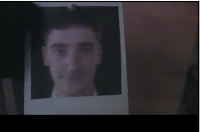 We incorporated violence into our sequence, the aftermath showing the dead body and a police detective investigating it. This is a convention of thriller films; to show the crime scene and the detective.
We incorporated violence into our sequence, the aftermath showing the dead body and a police detective investigating it. This is a convention of thriller films; to show the crime scene and the detective.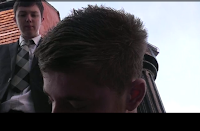 The antagonist left a signature item behind on his victim, which is conventional for serial killer films, such as 'Se7en' (Fincher, 1999) and 'Subject Zero' (Merhige, 2004) whose serial killers have a specific motive and way of killing their victims.
The antagonist left a signature item behind on his victim, which is conventional for serial killer films, such as 'Se7en' (Fincher, 1999) and 'Subject Zero' (Merhige, 2004) whose serial killers have a specific motive and way of killing their victims. 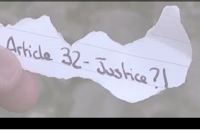 The form for our opening sequence was linear, and showed two lines of action inter-cut, and short scenes from a flash-back. I believe this is developing on the forms of real thriller and horror film openings, as they usually show a flashback at the start and then continue the narrative in the present, whereas our production integrates the flashbacks and main line of action into the same sequence. However, the flashbacks were in black and white which implies that they are in the past. Most films will show a flashback in a different colour wash to the main line of action, including black and white, so this technique is a convention of all films.
The form for our opening sequence was linear, and showed two lines of action inter-cut, and short scenes from a flash-back. I believe this is developing on the forms of real thriller and horror film openings, as they usually show a flashback at the start and then continue the narrative in the present, whereas our production integrates the flashbacks and main line of action into the same sequence. However, the flashbacks were in black and white which implies that they are in the past. Most films will show a flashback in a different colour wash to the main line of action, including black and white, so this technique is a convention of all films.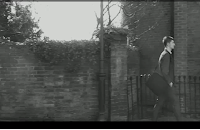
How does your media product represent particular social groups?
Our media product has three characters, all of which are male. The victim is from a middle-class background which is shown by his costume and props, as he is wearing a suit and holding a laptop bag. In our production, he is represented as an 'average' young adult with no stereotypes being displayed. The detective is also represented in this way, which is a dominant ideology in thriller films, that the 'good' characters are successful (conveyed through the use of costume as they wear suits) characters from a middle class background.
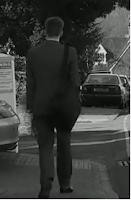 The social background of the antagonist is not explicitly shown, although it can be conveyed that he had a challenging upbringing which made him psychologically insecure which makes him commit the crimes, and possibly from a working class background. This is conveyed through his costume, consisting of dark clothing including a hoodey and tracksuit. However, this ideology is somewhat challenged, as he commits the murder successfully, has committed previous murders and leaves clues for the detective implying that he is intelligent, which stereotypically would not have been expected from someone from a working class background.
The social background of the antagonist is not explicitly shown, although it can be conveyed that he had a challenging upbringing which made him psychologically insecure which makes him commit the crimes, and possibly from a working class background. This is conveyed through his costume, consisting of dark clothing including a hoodey and tracksuit. However, this ideology is somewhat challenged, as he commits the murder successfully, has committed previous murders and leaves clues for the detective implying that he is intelligent, which stereotypically would not have been expected from someone from a working class background. Our production conforms to dominant ideologies in film productions, as it is an action-driven sequence with the protagonist and antagonist being males, which is conventional for most thriller films. However, the victim is a male character, which may be seen as challenging dominant ideologies of women being the victims of a serial killer as they may be stereotypically portrayed as vulnerable.
Our production conforms to dominant ideologies in film productions, as it is an action-driven sequence with the protagonist and antagonist being males, which is conventional for most thriller films. However, the victim is a male character, which may be seen as challenging dominant ideologies of women being the victims of a serial killer as they may be stereotypically portrayed as vulnerable. What kind of media institution might distribute your media product and why?
I believe that our product would most likely be produced by a conglomerate, and therefore an industrial film. This is because our production conforms to many thriller/horror convention as previously mentioned, and thriller films appeal to a mass audience of 15-24, 25-34, 35-44, and 45+ as they feature action, appealing to the younger audiences, and mystery which appeals to the wider audience.
Our production is a conventional thriller film, with horror elements such as the violence, so would be produced and distributed by a conglomerate, such as NBC Universal. The company would make use of symbiotic relations between the production, distribution and exhibition companies, all owned by the same conglomerate. The production company, such as Universal Studios, would invest a lot of time and money into producing the film using sets and shooting on suitable locations. The distribution companies, for example Optimum Releasing, will organise how the film will be advertised, most likely through television and cinema advertisements in the form of trailers, posters, billboards and making use of Web 2.0 applications such as Facebook and Youtube to spread to a wider range of audiences. The film would then be exhibited on a wide release, being shown in multiplexes across the market territory to obtain a wide range of audiences.
The production company, such as Universal Studios, would invest a lot of time and money into producing the film using sets and shooting on suitable locations. The distribution companies, for example Optimum Releasing, will organise how the film will be advertised, most likely through television and cinema advertisements in the form of trailers, posters, billboards and making use of Web 2.0 applications such as Facebook and Youtube to spread to a wider range of audiences. The film would then be exhibited on a wide release, being shown in multiplexes across the market territory to obtain a wide range of audiences.

What have you learnt about technologies from the process of constructing this product?
I have learnt how to use the HD cameras that we recorded our footage on, and I have learnt to use Adobe Premiere Elements 8.0 which we used to edit our footage by;
- Cutting
- Organising our clips
- Applying effects
- Applying transitions
- Applying titles
- Exporting our final product


The effects we added to our production included a black and white colour wash, to indicate that the sequence in black and white happened in the past, and also a fade to white, which we used as a transition between the two lines of action. An editing technique which we used effectively were jump cuts, which we used with a blur effect, during our murder sequence. A video of the effects we used can be found here.
We used freesound.org to find and download sound effects for our production, including a sound used to build tension and the sound of a camera taking a photograph which we used at the end of our opening. Other sounds, such as the music, we obtained from a copyright free source on the school system. Using blogger.com has also been highly beneficial for the entire group, as it has enabled us to keep track of our production and post a record of our research, group decisions and shoots. The blog archive also enabled us to keep track of our work, and the ability to edit our posts allowed us to improve on past work.
Using blogger.com has also been highly beneficial for the entire group, as it has enabled us to keep track of our production and post a record of our research, group decisions and shoots. The blog archive also enabled us to keep track of our work, and the ability to edit our posts allowed us to improve on past work. I have also learnt to use Prezi, a presentation software which is free to use on the internet. This enabled me to pitch our opening sequence in an interactive way and allowed our group to add to our moodboard of ideas.
I have also learnt to use Prezi, a presentation software which is free to use on the internet. This enabled me to pitch our opening sequence in an interactive way and allowed our group to add to our moodboard of ideas. Surveymonkey.com allowed the group to conduct audience research into what the audience expect from a thriller film opening and if they thought that our idea of a thriller film opening would be enjoyable and conventional. The website allowed the survey to be taken online, and our survey was taken by 19 individuals. Our results helped us to adapt our opening so that it would be a successful conventional thriller opening, and allowed us to decide on the font we wanted for our title and the iconography we were going to use.
Surveymonkey.com allowed the group to conduct audience research into what the audience expect from a thriller film opening and if they thought that our idea of a thriller film opening would be enjoyable and conventional. The website allowed the survey to be taken online, and our survey was taken by 19 individuals. Our results helped us to adapt our opening so that it would be a successful conventional thriller opening, and allowed us to decide on the font we wanted for our title and the iconography we were going to use.Another website we used was youtube.com, which allowed us to post our preliminary task, final opening sequence and interviews onto the Internet, enabling us to get an embed code which allows us to embed our clips and post them on our blog.

Friday, 8 April 2011
Thursday, 7 April 2011
Group: 7/04/11
Group: Sound Used
Wednesday, 6 April 2011
Group: 05/04/11 Work
Tuesday, 5 April 2011
Group: 03/04/11 Work
Monday, 4 April 2011
Group: Example of callsheet and risk assesment
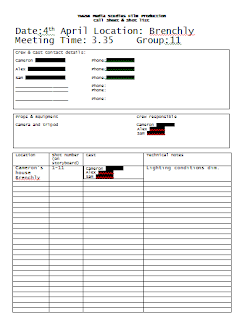 First off the call sheet identifies who is responsible for the kit and what kit we have taken out. Also it includes telephone numbers of the group for emergency contact. It identifies where we are going on our shoot.
First off the call sheet identifies who is responsible for the kit and what kit we have taken out. Also it includes telephone numbers of the group for emergency contact. It identifies where we are going on our shoot.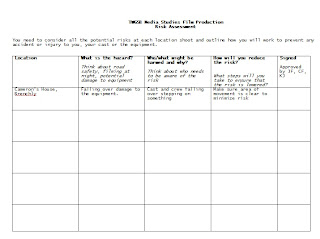
Thursday, 31 March 2011
Group: 31/03/11 Progress
Wednesday, 30 March 2011
Group: Wednesday 30/03/11 Group Progress:
Group - Tuesday 29/03/11 work
Tuesday, 29 March 2011
Group: Ideas Movieclips.com
Monday, 28 March 2011
Group: Editing
Group: Wednesday/Thursday/Friday Lesson
- http://www.freesound.org/samplesViewSingle.php?id=33637 This sound will be used when the items on the Psychopath's bed disappear.
- http://www.freesound.org/samplesViewSingle.php?id=716 This sound will be used at the end of our scene in the Psychopath's room, as it builds tension as the the scene fades to black.
On the Friday lesson with the sounds we had found we put onto our opening and it worked really well.
GROUP Storyboard Completion

Sunday, 27 March 2011
Feeback
Thursday, 24 March 2011
Group: Final of the beginning of the opening:
We didn't believe he would need a tripod, and thus trying to keep the camera steady posed a problem, however he got round this by making the whole section as a POV with a few bird's eye views too.
Also another difficult factor was the lighting, which had to create a shadow of the killer walking around the room and looking at some pictures, but not to show the shadow of the camera being held. Cameron got round this problem by using a desk lamp, as the only source of light which created brilliant shadow effect, and also an sinster dark look to the bedroom, which is representational to the killer.
All in all the shot went well, however we have learnt from this reccie that we need to have at least two people at every shoot.
Sunday, 20 March 2011
Tuesday, 15 March 2011
First Shoot
- Our first shoot was overall, unsuccessful as there were some key issues we discovered while shooting and editing.
- We shot outside during the day, and it was too light for our production of a thriller/horror opening sequence.
- After editing, we have found that we use our time effectively, as we had over four minutes of edited footage which is too long for our production.
- However, our first shoot has highlighted the factors and issues we must consider when planning and shooting.
Monday, 7 March 2011
Group: Preliminary Task findings
One major thing we have found is trying to use sound effectively, we have realized that it transforms a piece of footage, however we need to work on and execute the art of fading in and out of bits of music as to not add distortion effects where not necessary or wanted.
Another major thing we have learned from this piece of filming is the difficulty of portraying violence in this case a punch and a kick. We filmed the punch with myself (Cameron Moffatt) acting the punch out extremely slowly and tried in editing to quicken the pace of the punch however this didn't work in the way we had hoped it would. Also the kick didn't seem to convey or have enough power to seem real, thus we have deduced we need to attempt to work on the realism of our productions.
It is important for us to focus on realism as we are hoping for our production to be highly realistic and plausible in order to capture the audiences attention and keep them on edge throughout our opening which is a key part of a Thriller/Horror genre.
Location Reccie
Also the angle of shot is very important in order to insert a sense of distortion within our production.
Finally due to the fact within one of our locations there is a unmovable mirror we will have to be careful in order not to have shadows present or the film crew itself. This Location Reccie has made us aware of effects needed and also camera positioning both angle and actually were it is in the room.
Tuesday, 1 March 2011
Tuesday, 15 February 2011
Monday, 14 February 2011
Group Wilderness Woods Recce Evalution
- The wilderness recce gave us all an insight into about how to approach the filming of our opening.
- First key area we must manage is our time management of when doing certain shots, some of the time we over thinked the shots and spent too long on them others we didn't and prove to be quiet rushed for example cutting to early.
- When preparing whats need to be done and how it will be laid out, we should make sure that we keep with continuity in order to create sense of continuous action, however not to go overboard and do to many shots to show every movement and not to go to the other extreme and to go to fast through the story and get no sense of what is happening.
- The other problem we found with continuity is that making sure when filming keep the right positions and same way in which dressed as in our practice recce showed that Cameron had forgot to keep his hood up thus breaking the continuity however over flaus such as direction and placing of when I was running.
- Overall the recce was a valuable task and also upon the editting of the clip helped us to gain knowledge and understanding of how to use the equipment and how to use it effectively.
Sunday, 13 February 2011
CF feedback - product research/ideas dvpt
1. All 3 technical analysis are not detailed enough - look at some of the other groups' work
2. Cameron - you must use ICT more effectively in your posts - use images, highlight key terms. When presenting the treatment and shot ideas you need to think about layout of posts
3. Ensure that all your ideas on location, costume, narrative are clearly documented
Sam - prezi doesn't load?
Friday, 11 February 2011
SH: Institutional Context
If our opening sequence were to be developed and made into a film, it would most likely be produced by a conglomerate and therefore be an industrial film. This is because the film is a thriller, which are produced mainly by large studios and independent film companies may struggle to gather enough finance for a film belonging to the thriller genre, as actions scenes are used and many conventional props and locations, such as police stations and weapons, may be expensive.
Distribution
The film would be distributed through a company owned or co-owned by the production company as they may be run by a conglomerate. It would most likely be on wide release to achieve maximum sales across the market, and would be marketed using posters, trailers on the TV and the Internet, and other viral marketing methods such as advertising on Facebook.
Exhibition
The film may be exhibited by companies owned or co-owned by a conglomerate, for example the Odean cinema chain is owned by Vivendi Universal, which may be beneficial to the film as it can take priorities in the cinema by having prime time slots and being advertised. The film would not be a tentpole however, as it would not appeal to the four quadrants, but would still be a mainstream film which will still appeal to a large audience; 15-24 age group as it contains some action and violence, and also 25-34, 35-44, 45-54 age groups as well as it is enigmatic and audiences will be intrigued to find out what happens.
Thursday, 10 February 2011
Technical Issues with cameras
Monday, 7 February 2011
Technical Analysis: Memento: Christopher Nolan, 2000:
- I have learnt that even in openings when not much happens there are many cuts which show the audience each piece of mise-en-scene and gives ideas into the audiences thoughts of what has happened, why it has happened and when it happened.
- Also the different angles of shots gives the audience different reactions towards certain characters, by having a birds-eye view of the dead man there is no emotional connection with the body and feel no sympathy for this person. But by having a low angle looking up at the man in the suit makes the audience respect him and view his power and control over the situation.
- The quickening of the cutting rate also makes the audience feel tension and anxiety as something is about to happen or be revealed which is enigmatic for the audience and keeps them interested in your opening and thus your entire film too.
Technical Analysis: Suspect Zero
- For the technical analysis, I analysed 'Suspect Zero' in which there were around 17 shots. I believe this is quite short for an opening sequence, and this may be due to the title sequence showing the titles for quite a long period of time.
- I think we should not spend too long showing the title, actors and crew members of the film as this will limit the time we will have to show our enigmatic opening.
- We could also incorporate the titles into the action, rather than having the title sequence and the action completely seperate.
Sunday, 6 February 2011
AT Technical Analysis
Shot 1: Shows a girl making a braclet, use of a CU to show the name on the braclet and what she is doing, with a POV shot to reveal the braclet and get an insight into the characters view point and use of iconography of the braclet which not expected in the genre of a thriller, use of props being the beads and braclets connotes child environment.

Shot 2: Shows her father talking to her about what she is doing. We do not see him however a CU of the machine he is working at is shown and the use of a sound bridge to make out he is talking to her and they are in conversation. Machinery often linked with males as being rugged job however he is doing a precise job but still stereotype of males fixing things or working.
Shot 3: Cuts to the father talking MCU. Doesnt apear to be doing strenuious work and wearing relaxed casual clothing.
Shot 4: Conversation between the father and daughter her talking about what she is making a POV shot used to see his eyeline looking down on her. Props use of table show her sitting up at the table working.

Shot 6 -13: Conversation continuing with introduction of the mother in shot 7 with use of sound bridge almost as if she is calling out to the father to get him to answer the door.
Shot 14: Father walks over to the door to answer it, use of stedi-cam following him effect. Nice middle class house due to quiet fancy and neat good lighting throughout house.
Shot 15-19: Father is hit with a baseball bat and is beaten up by one man while the other enters and turns of the lights and then seals the mans hands with varying shot sizes from mid shots to CU of the mans hands and facial expresions. Both attackers wearing rugged clothing and have a rough apearence especialy main antagonist.
 Shot 20 -21: Shows the mother entering the hallway of where he is being beaten, shot goes from a mid shot to a MCU to get her reactions more. The use of the reaction shot as we hear the scream before we see her.
Shot 20 -21: Shows the mother entering the hallway of where he is being beaten, shot goes from a mid shot to a MCU to get her reactions more. The use of the reaction shot as we hear the scream before we see her.Shot 22: Shows the mans legs running over to the women with use of stedi-cam to make it feel like a head turn. However it is a quick swish pan to help create the speed of it.
Shot 23: Reaction shot shows what the women was looking at her husband on the floor tied up and trying to free himself.
Shot 24-28: Cutting rate picks up as women is thrown into a cabinet followed by the masking up of the mans lips to keep him quiet all in MCU of the man to show him strugle and show his positioned where as the women is shot in a mid shot.

Shot 29: We get a CU of the attackers face and of the knife in his hand showing the iconography and symbolism that the knife represents especisaly in this genre. Antagonist talks however doesn't seem to lead to anything and we don't seem to get any clues as to why leaving mystery.
Shot 30: He is stabbed with use of the sound to dramatise the knife going into his body. Also frammed in the shot is his face to show his reaction to the build of before getting stabbed then as he is stabbed.
Shot 31: Then the blood is wiped on his jumper all in a MCU. Seen as more of a robery but also an assult.
Shot 32: The two men pack up to leave and it fades to black connoting his eyes clossing also the slow fade connotes how quickly it has happend and the slow fade gives time to reflect on the opening seqeunce.
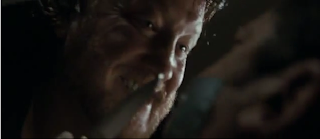
Review:
- Overall from the technical analysis I undertook, helped me to get an understanding of the variety of shots used and how these can be interlinked
- How character exposition is key in this opening, and is something we should think about when doing our opening.




